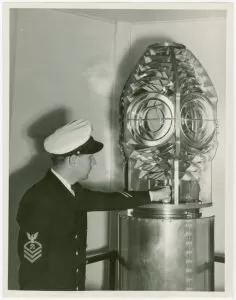
Fresnel lenses served as the heart of lighthouses around the world, including at Old Mackinac Point. Invented by French scientist Augustin-Jean Fresnel in 1819, these brass and glass beehives bent, magnified, and focused light to project brilliant beams for miles.

To understand how Fresnel’s lenses worked, it is first important to answer a simple question: what is light? Light is made up of electromagnetic waves, which are vibrating electric and magnetic fields. These waves are generated by the movement of electrons in and out of their orbits around the nucleus of an atom. All electromagnetic waves travel at 186,000 miles per second, but they have different wavelengths and frequencies. Waves with a shorter wavelength have a higher frequency, and thus carry more energy. This range of wavelengths is called the electromagnetic spectrum. Humans can only see a small part of the electromagnetic spectrum, which presents itself as visible light. Light waves usually move in straight paths, but can be reflected or refracted. Reflection occurs when light waves bounce off a surface. Refraction is the bending of light waves as they pass from one medium to another, and humans can refract light using prisms.
In the center of Augustin Fresnel’s lenses, a simple plano-convex (flat on one side, curved on the other) lens magnified light. Concentric rings of prisms around the central lens refracted more light so that it joined the horizontal beam. Together, these pieces formed a dioptric, or refractory, lens. However, since traditional prisms could only bend light to 45°, light emanating from the top and bottom of the light source was lost. Fresnel added more angular prisms, which could reflect light at greater angle, above and below the dioptric area. These catoptric, or reflecting, prisms directed more light into the central beam. When combined, the dioptric and catoptric components formed a new type of apparatus that Fresnel called a catadioptric lens.
Today, the original glass Fresnel lenses have been removed from most lighthouses and replaced by acrylic lenses. Although smaller and easier to maintain, these modern lenses still rely on the design and scientific principles of Fresnel’s invention.

At Old Mackinac Point, we are fortunate to have two historic Fresnel lenses on display. One, likely removed from the South Fox Island light station sometime in the 1930s, is displayed lit up and spinning in a new science and technology exhibit in the keepers’ quarters. Meanwhile, the original lens from Old Mackinac Point, on loan from the U.S. Coast Guard, greets visitors as they first enter the lighthouse. Together, these lenses help tell the story of how science and technology blended together to help keep sailors safe in the Straits of Mackinac. We hope you’ll join us at the lighthouse soon to see these lenses (and much more!) and learn about their role at Old Mackinac Point.









